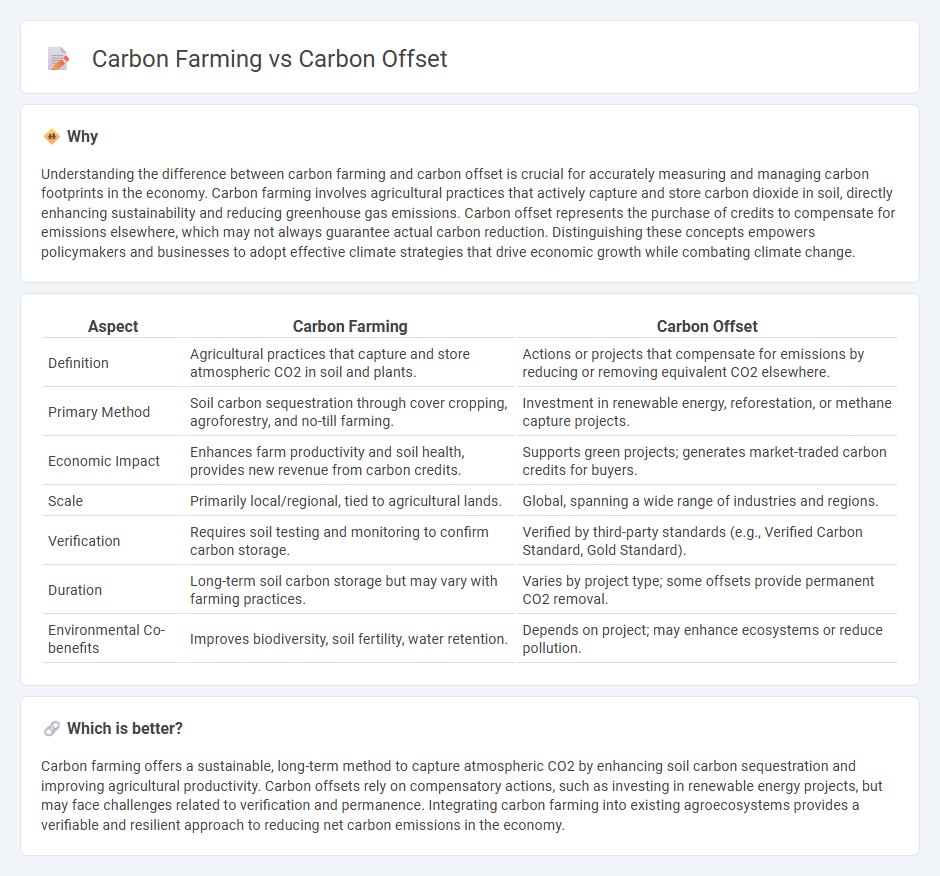
Carbon farming enhances soil carbon sequestration by implementing agricultural practices that capture atmospheric CO2, directly improving soil health and crop yields. Carbon offset projects, on the other hand, reduce carbon footprints by funding external initiatives like reforestation or renewable energy, balancing emissions beyond farm-level activities. Explore the economic impacts and sustainability benefits of both carbon farming and carbon offsets to understand their crucial role in climate-smart investment strategies.
Why it is important
Understanding the difference between carbon farming and carbon offset is crucial for accurately measuring and managing carbon footprints in the economy. Carbon farming involves agricultural practices that actively capture and store carbon dioxide in soil, directly enhancing sustainability and reducing greenhouse gas emissions. Carbon offset represents the purchase of credits to compensate for emissions elsewhere, which may not always guarantee actual carbon reduction. Distinguishing these concepts empowers policymakers and businesses to adopt effective climate strategies that drive economic growth while combating climate change.
Comparison Table
| Aspect | Carbon Farming | Carbon Offset |
|---|---|---|
| Definition | Agricultural practices that capture and store atmospheric CO2 in soil and plants. | Actions or projects that compensate for emissions by reducing or removing equivalent CO2 elsewhere. |
| Primary Method | Soil carbon sequestration through cover cropping, agroforestry, and no-till farming. | Investment in renewable energy, reforestation, or methane capture projects. |
| Economic Impact | Enhances farm productivity and soil health, provides new revenue from carbon credits. | Supports green projects; generates market-traded carbon credits for buyers. |
| Scale | Primarily local/regional, tied to agricultural lands. | Global, spanning a wide range of industries and regions. |
| Verification | Requires soil testing and monitoring to confirm carbon storage. | Verified by third-party standards (e.g., Verified Carbon Standard, Gold Standard). |
| Duration | Long-term soil carbon storage but may vary with farming practices. | Varies by project type; some offsets provide permanent CO2 removal. |
| Environmental Co-benefits | Improves biodiversity, soil fertility, water retention. | Depends on project; may enhance ecosystems or reduce pollution. |
Which is better?
Carbon farming offers a sustainable, long-term method to capture atmospheric CO2 by enhancing soil carbon sequestration and improving agricultural productivity. Carbon offsets rely on compensatory actions, such as investing in renewable energy projects, but may face challenges related to verification and permanence. Integrating carbon farming into existing agroecosystems provides a verifiable and resilient approach to reducing net carbon emissions in the economy.
Connection
Carbon farming involves agricultural practices designed to capture and store atmospheric carbon dioxide, directly reducing greenhouse gas emissions and contributing to climate change mitigation. Carbon offsets represent measurable carbon reductions from projects like carbon farming that individuals or companies purchase to compensate for their own emissions. This connection links sustainable agriculture with economic mechanisms facilitating carbon markets and environmental responsibility.
Key Terms
Emissions Reduction
Carbon offset involves purchasing carbon credits to compensate for emissions by funding projects that reduce greenhouse gases, while carbon farming actively reduces emissions through agricultural practices like cover cropping and agroforestry that sequester carbon in soil. Emissions reduction in carbon farming is direct and measurable on farms, enhancing soil health and biodiversity alongside carbon capture. Explore innovative carbon farming techniques to maximize your emissions reduction impact today.
Carbon Sequestration
Carbon offset involves compensating for carbon emissions by investing in projects that reduce or capture greenhouse gases, whereas carbon farming focuses on agricultural practices specifically designed to enhance carbon sequestration in soil and vegetation. Carbon sequestration in carbon farming promotes soil health and increases biodiversity, offering long-term benefits alongside climate mitigation. Explore how these strategies contribute uniquely to carbon reduction and sustainability efforts.
Market Mechanisms
Carbon offset involves purchasing credits to compensate for emission reductions elsewhere, enabling companies to meet regulatory or voluntary climate targets while supporting projects like renewable energy and reforestation. Carbon farming refers to agricultural practices that enhance carbon sequestration in soil and biomass, generating verifiable carbon credits directly linked to improved land management and ecosystem restoration. Explore these market mechanisms to understand their impact on sustainability and investment opportunities.
Source and External Links
Carbon offsets and credits - Carbon offsets allow entities to compensate for their greenhouse gas emissions by investing in projects that reduce emissions elsewhere.
Carbon Offsetting Services - This service provides carbon offset projects that meet international standards, helping individuals and organizations balance their emissions by funding emission savings globally.
Carbon Offsets - Carbon offsets are certificates that support projects reducing CO2 in the atmosphere, allowing buyers to offset their emissions without directly lowering their own emissions.
 dowidth.com
dowidth.com